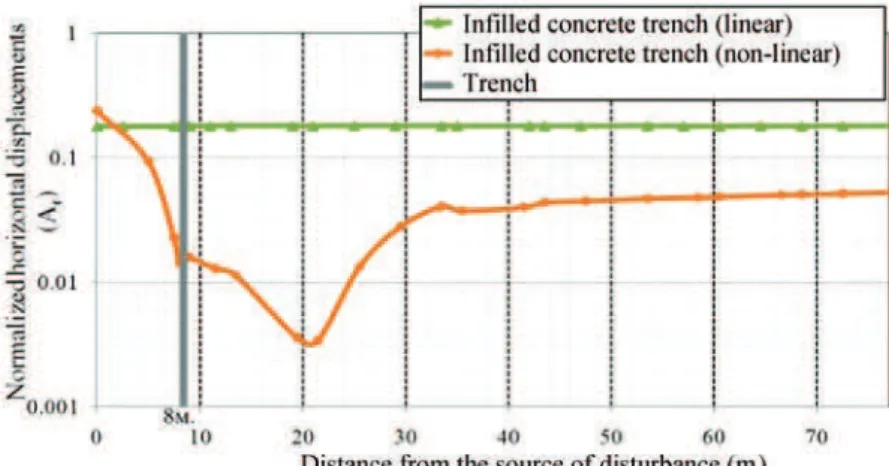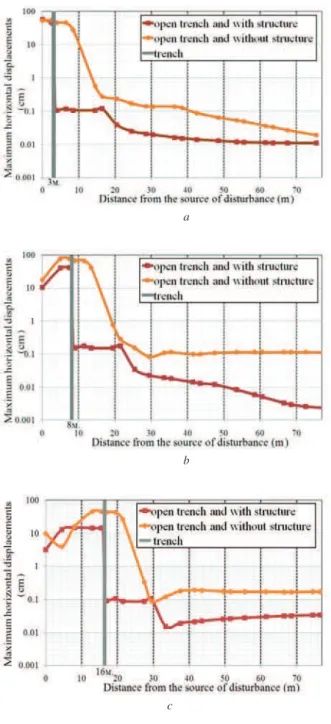УДК 624.131.5
V.V. Orekhov, H. Negahdar
MGSU
EFFICIENCY OF TRENCH BARRIERS USED TO PROTECT
STRUCTURES FROM DYNAMIC LOADS AND STUDY
OF THE STRESS — STRAIN STATE OF SOILS BASED ON STRAIN
HARDENING AND ELASTIC MODELS
Wave barriers are intended to mitigate vibration transmission in the soil. They in-clude open and inilled trenches, sheet piles, etc. In this study, a two-dimensional inite difference element analysis was performed using FLAC-2D software as a research into the eficiency of open and inilled barriers exposed to dynamic loading with or without the presence of structures. In this contribution, two constitutive models are considered to study the soil response in the elastic and elastoplastic range with account for yield, fail-ure and potential functions of soil plasticity. The results were assessed with account for reduced soil particle displacements on the ground surface exposed to impulse loading.
The numerical analysis has proven that the results obtained by assigning elastic properties to the soil material fail to comply with the results obtained by analyzing the model having non-linear properties of soils. The presence of a structure produces a sig-niicantly larger effect onto the eficiency of barriers by reducing the surface wave energy.
Key words: strain-hardening model, elastic model, wave barrier, attenuation curves.
Wave barriers are used to reduce ground-borne vibrations induced by differ-ent sources such as machine foundations, earthquakes, dynamic compaction, high speed trains, etc. Most of these vibrations propagate in the soil in the form of surface waves, and they can run to long distances. Geometry, location and compo-sition of a wave barrier inluence the isolation eficiency. In the literature cover-ing ground-borne vibrations, D.D. Barkan (1962) was the irst scientist who used screening as protection from vibration waves in case of open trenches. He reported that open trench dimensions were large enough relative to the wavelength of sur-face motions [1, 2]. In the three past decades, extensive research into the eficiency of surface wave screening in the soils [3—5] was completed by Russian scientists like V.K. Musaev and others.
The inite difference method is, perhaps, the oldest numerical technique em-ployed to solve sets of differential equations, given the availability of initial and/ or boundary values. In this study, the 2D inite difference element model was de-veloped using FLAC software package. The choice of the constitutive model may have a signiicant inluence on the numerical results generated in the course of any analysis of geotechnical problems. Every constitutive model has its strengths and weaknesses.
Initial Residual Initial Residual
Half-space 1.865 0.288 0.625 1 2 20 30
Concrete 2.400 104 138.8
Structure
(concrete)* 432 * 18.8* 25.2*
*derived value
In this study, the structure (10 meters wide and 15 meters high) was approximated to an equivalent rectangular shape. The structure was placed on the right side of a bar-rier at the ground level. The mat foundation of the structure was located 1.0 m below the ground surface. In this paper, the authors assume that the vertical impulse dy-namic load of the triangular shape is induced onto the soil surface having a one meter diameter located on the left side of the barrier (exposure duration = 0.1 second). The maximal dynamic load value was Р = 1.0 МN. All geometrical parameters of the model are provided in Figure 1.
а
b
c
d
of 8 m from the left side of the trench. Figures 1a, 1b, 1c, and 1d show the
de-cay curve of the ground motion vs. the distance on a semi-logarithmic scale, in
the event of exposure to the impulse load. The igures demonstrate that results
of the analysis based on the soil model that has an elastic modulus are different
from the results of the analysis based on the strain-hardening modulus, and the
values of the former are higher than those of the latter. The authors demonstrate
that the damping performed by the material has some inluence onto the
bar-rier eficiency. The reason for this phenomenon may consist in the fact that the
ground motion is suppressed both geometrically and materially; therefore, the
soil damping value is relatively high. Another source of discrepancy between
linear and nonlinear results is that in the event of dynamic loading substantial
strain can induce plastic areas in nonlinear materials, or local heterogeneity of
the soil. Thus, the model simulating nonlinear properties can be reliably used
to extrapolate the results and to implement an extensive parametric study into
the behaviour of open and inilled trench barriers.
Three locations of the excitation system were chosen to study the inluence
of the distance to the source of disturbance onto the protective effectiveness of
the isolation system: 3.0, 8.0, and 16.0 m from the left side of the trench.
a
b
c
Fig. 2: Ground motion following impulse loading in case of presence and absence of a structure, in case of presence and absence of a trench. Trench depth = 10 m; W = 50 cm. a — trench-to-structure distance (L) is assumed as 3 m; b — trench-to-structure distance (L) is assumed as 8 m; c — trench-to-structure distance (L) is assumed as 16 m
b
c
Fig. 3: Ground motion following impulse loading in the presence of a structure, in the presence of an open trench. Trench Depth =10 m; trench width =50 cm. а — trench-to-structure distance (L) is assumed as 3 m; b — trench-to-structure distance (L) is assumed as 8 m; c — trench-to-structure distance (L) is assumed as 16 m
(1) The results demonstrate higher values for soils having elastic properties than those having strain-hardening ones.
(2) Whenever a wave reaches the barrier, the results demonstrate a very steep decay in the nonlinear soil behaviour.
(3) Models having a structure demonstrate their higher eficiency irrespective of the presence of barriers.
(4) It has been identiied that the longer the distance between the loading source and the trench, the higher the protective eficiency of a structure in case of its presence.
References
1. Barkan D.D. Dynamics of Bases and Foundations. McGraw-Hill Book Company Inc., 1962, pp. 374—406.
2. Al-Hussaini T.M. and Ahmad S. Numerical and Experimental Studies on Vi-bration Screening by Open and Inilled Trench Barrier. International Workshop on Wave Propagation, Moving Load and Vibration Reduction. Brookield, 2000, pp. 241—250.
3. Musaev V.K., Kurantsov V.A. O razrabotke metodiki rascheta sooruzheniy neglubok-ogo zalozheniya pri vnutrennikh vzryvnykh volnovykh vozdeystviy [Development of Meth-odology of Analysis of Shallow Foundation Structures Exposed to Internal Explosive Wave Impacts]. Vestnik Rossiyskogo universiteta druzhby narodov. Seriya problemy kompleksnoy bezopasnosti. [News Bulletin of Russian Peoples’ Friendship University. Comprehensive Safety Problems Series]. 2008, no. 1, pp. 75—76.
4. Musaev V.K., Sazonov K.B. Chislennoe modelirovanie bezopasnosti sooruzheniy neglubokogo zalozheniya pri vneshnikh vzryvnykh vozdeystviyakh [Numerical Modeling of Safety of Shallow Foundation Structures Exposed to External Explosive Impacts]. Vest-nik Rossiyskogo universiteta druzhby narodov. Seriya problemy kompleksnoy bezopasnosti. [News Bulletin of Russian Peoples’ Friendship University. Comprehensive Safety Problems Series]. 2008, no. 3, pp. 6—13.
5. Musaev V.K. Komp’yuternoe modelirovanie bezopasnosti okruzhayushchey sredy s pomoshch’yu polostey pri vzryvnykh vozdeystviyakh v sooruzheniyakh neglubokogo za-lozheniya [Computer Simulation of Environmental Safety Using Cavities in Case of Ex-posure of Shallow Foundation Structures to Explosions] Bezopasnost’ i ekologiya tekhno-logicheskikh protsessov i proizvodstv. Materialy Vserossiyskoy nauchno-prakticheskoy konferentsii. Poselok Persianovskiy Rostovskoy oblasti. [Safety and Ecology of Manufactur-ing and Production Processes. Works of the All-Russian Scientiic and Practical Conference. Persianovskiy Settlement, Rostov Region.] Donskoy gosudarstvennyy agrarnyy universitet [Don State University of Agriculture]. 2009, pp. 110—115.
6. Orekhov V.V., Negakhdar Kh. Nekotorye aspekty izucheniya primeneniya tran-sheynykh bar’erov dlya umen’sheniya energii poverkhnostnykh voln v grunte [Particular Aspects of Research into Application of Trench Barriers Aimed at Reduction of the Surface Wave Energy in the Soil]. Vestnik MGSU [Proceedings of Moscow State University of Civil Engineering]. 2013, no. 1, pp. 98—104.
Поступила в редакцию в феврале 2013 г.
ДЕФОРМИРОВАННОГО СОСТОЯНИЯ ГРУНТОВ НА ОСНОВАНИИ МОДЕЛЕЙ МЕХАНИЧЕСКОГО УПРОЧНЕНИЯ И УПРУГОГО ДЕФОРМИРОВАНИЯ
Защитные барьеры предназначены для подавления волн, распространяющих-ся в грунте. Защитные барьеры представляют собой открытые и засыпные тран-шеи, шпунтовые сваи и пр. В данном исследовании проведен двумерный анализ элементов методом конечных разностей с помощью программного обеспечения FLAC-2D. Программное обеспечение использовалось для определения эффек-тивности открытых и засыпных траншей при воздействии динамических нагрузок, как при наличии, так и в отсутствие сооружений. Рассмотрены две конструктивные модели упругой и упругопластичной реакции грунта. При оценке результатов учи-тывался параметр смещений поверхности грунта под воздействием динамической нагрузки.
Ключевые слова: модель механического упрочнения, модель упругого де-формирования, волновой барьер, кривая затухания.
Библиографический список
1. Barkan D.D. Dynamics of Bases and Foundations. MacGraw-Hill Book Company Inc.,
1962, pp. 374—406.
2. Al-Hussaini T.M. and Ahmad S. Numerical and Experimental Studies on Vibration Screening by Open and Inilled Trench Barrier. International Workshop on Wave Propagation, Moving Load and Vibration Reduction. Brookield, 2000, pp. 241—250.
3. Мусаев В.К., Куранцов В.А. О разработке методики расчета сооружений
неглубокого заложения при внутренних взрывных волновых воздействий // Вестник Российского университета дружбы народов. Серия проблемы комплексной безопасности. 2008. Вып. 1. С. 75—76.
4. Мусаев В.К., Сазонов К.Б. Численное моделирование безопасности сооружений
неглубокого заложения при внешних взрывных воздействиях // Вестник Российского университета дружбы народов. Серия проблемы комплексной безопасности. 2008. № 3. С. 6—13.
5. Мусаев В.К. Компьютерное моделирование безопасности окружающей среды с
помощью полостей при взрывных воздействиях в сооружениях неглубокого заложения // Безопасность и экология технологических процессов и производств : Материалы Всеросс. науч.-практ. конф. Поселок Персиановский Ростовской области : Донской государственный аграрный университет, 2009. С. 110—115.
6. Орехов В.В., Негахдар Х. Некоторые аспекты изучения применения траншейных
О б а в т о р а х : Орехов Вячеслав Валентинович — доктор технических наук, про-фессор кафедры механики грунтов оснований и фундаментов, ФГБОУ ВПО «Москов-ский государственный строительный университет» (ФГБОУ ВПО «МГСУ»), 129337, Россия, г. Москва, Ярославское шоссе, д. 26; orehov@rambler.ru;
Негахдар Хассан — аспирант кафедры механики грунтов оснований и
фунда-ментов, ФГБОУ ВПО «Московский государственный строительный университет»
(ФГБОУ ВПО «МГСУ»), 129337, Россия, г. Москва, Ярославское шоссе, д. 26; hassan_
negahdar@yahoo.com.



